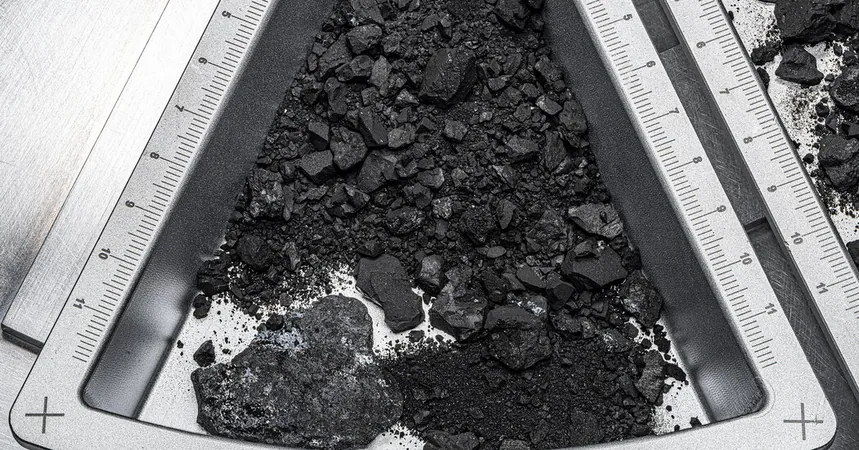
Astronauts May Snack on Asteroids: The Futuristic Food Revolution!
2024-10-03
Astronauts and Their Nutritional Challenges
Astronauts on long-term deep space missions face a daunting challenge: they can't bring enough freeze-dried meals to sustain their nutritional needs, and growing fresh produce onboard remains a technological hurdle. In light of these constraints, a group of innovative engineers is suggesting an unexpected solution—why not turn to asteroids for sustenance?
Innovative Research on Asteroids
According to a groundbreaking study published in *The International Journal of Astrobiology*, researchers propose that future space travelers could harvest organic components from asteroidal materials. Instead of munching on rocks directly, a process would be developed to break down asteroid materials into hydrocarbon compounds, which would then serve as food for bacteria. Once the bacteria thrive, astronauts could consume them in a much more palatable format known as "biomass."
The Inspiration from Earth
This novel approach draws inspiration from terrestrial experiments sponsored by the Defense Advanced Research Projects Agency (DARPA). The ReSource program focuses on converting military waste into useful materials—transforming "trash to treasure," so to speak. A particular challenge lies in the management of Meals Ready to Eat (MREs), which come in durable plastic containers that last indefinitely. Joshua Pearce, an engineering professor at Western University, explains that these containers present an environmental dilemma. Instead of discarding or incinerating them, researchers considered whether they could transform the containers themselves into a food source.
Pyrolysis and Biomass Production
The process begins with pyrolysis, a method that breaks down plastic without oxygen. This produces solid, gaseous, and oily byproducts, with the oil feeding bacteria in a bioreactor. After the bacteria feed, they become an edible, nutritious biomass—albeit with a somewhat unappetizing initial appearance. Early attempts yielded a "flesh-colored slurry," but improvements resulted in a product more akin to caramel yogurt. However, before astronauts can indulge in this unique source of sustenance, safety tests to ensure edibility are paramount.
Exploring Asteroid Materials
Dr. Pearce's discussions with fellow space innovators revealed that the carbon-rich nature of asteroids could closely resemble that of plastic. This sparked an exploration into the possibility of microbial consumption of asteroidal materials. Annemiek Waajen, a researcher at Vrije Universiteit Amsterdam, has tested meteorite samples to see if microbes could metabolize their carbon. Her findings, indicative of the potential for asteroid-eating bacteria, suggest that these extraterrestrial remnants may have played a significant role in fostering early Earth’s habitability.
Potential Food Harvest from Asteroids
With promising results from the meteorite-eating experiments, Dr. Pearce's team conducted calculations to gauge how much food could be harvested from asteroids. Their calculations utilized asteroid Bennu, a space rock recently sampled by NASA’s OSIRIS-REx mission, with a total mass around 85.5 million tons. They discovered that in a worst-case scenario, the microbial decomposition of Bennu’s materials could sustain one astronaut for an astonishing 600 years. In a better scenario, that support could extend to 17,000 years! To sustain one astronaut for just one year, they would need between 5,500 and 175,000 tons of asteroid.
Challenges Ahead
However, before this asteroid buffet becomes a reality, extensive toxicity studies and technological developments are needed. Dr. Waajen acknowledges that while the biochemical potential exists, the actual implementation is far off. Creating a functioning asteroid mining system and an extensive bioreactor setup in space presents a monumental challenge.
The Future of Space Food Innovation
In the end, while the vision of munching on asteroid-based snacks is tantalizing, experts like Dr. Techtmann caution that translating Earth-based research to a space environment presents unique challenges. So, while space food innovation is on the horizon, the dream of asteroid cuisine is still in its early stages. Could this be the future of astronauts’ diets? Stay tuned for further developments in this interstellar food revolution!

 Brasil (PT)
Brasil (PT)
 Canada (EN)
Canada (EN)
 Chile (ES)
Chile (ES)
 España (ES)
España (ES)
 France (FR)
France (FR)
 Hong Kong (EN)
Hong Kong (EN)
 Italia (IT)
Italia (IT)
 日本 (JA)
日本 (JA)
 Magyarország (HU)
Magyarország (HU)
 Norge (NO)
Norge (NO)
 Polska (PL)
Polska (PL)
 Schweiz (DE)
Schweiz (DE)
 Singapore (EN)
Singapore (EN)
 Sverige (SV)
Sverige (SV)
 Suomi (FI)
Suomi (FI)
 Türkiye (TR)
Türkiye (TR)